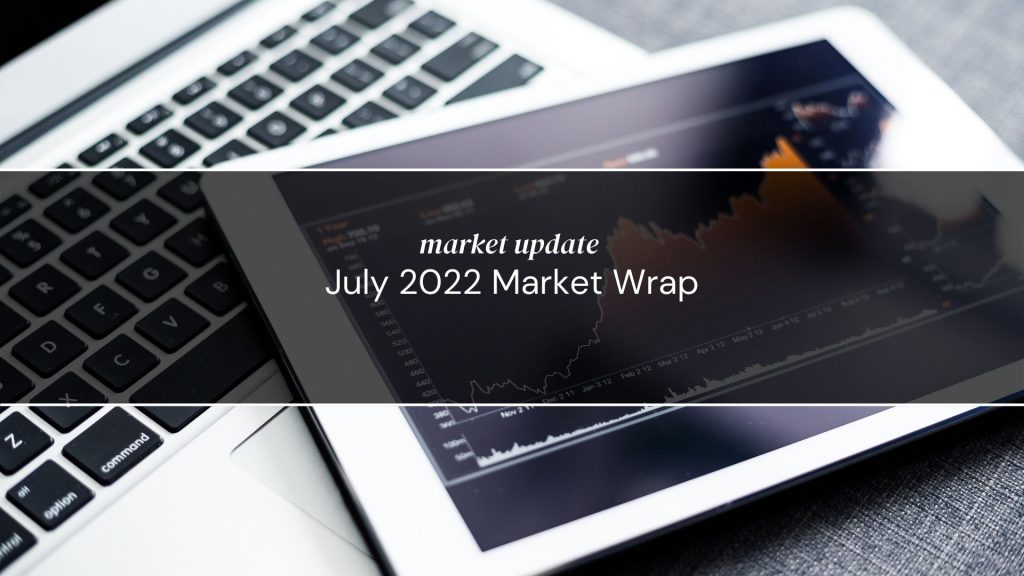Market Update: July 2022 Market Wrap Posted on August 9, 2022

Article by Count
Economic and market overview
- Equity and bond markets bounced back hard from disappointing returns in June, amid suggestions that rising interest rates in key regions will help bring inflation under control.
- Australian shares registered gains of more than 5%. Most major overseas share markets performed even more strongly – the MSCI World Index closed the month 8.0% higher, with selected markets enjoying double-digit gains. This made July the best month for risk assets since late 2020, when encouraging Covid vaccine trial results were first reported.
- The tone of earnings announcements among US firms for the three months ending 30 June was generally encouraging.
- Fixed income markets also generated solid positive returns, following dismal performance in the first half of 2022. A sharp drop in government bond yields in all key regions supported positive returns from sovereign bonds. In fact, returns from US Treasuries in July were the strongest in more than two years.
- Credit securities fared well too, as the general improvement in risk appetite saw spreads narrow.
- US: The US economy contracted in the three months ending 30 June. According to the latest available data, the economy shrank by 0.9% over the period, following a 1.6% contraction in the first quarter of the year. By one measure, this suggests the world’s largest economy is already in recession.
- Some observers argue that activity levels remain quite buoyant, however, and not consistent with a recessionary environment.
- The labour market also appears to remain healthy. More than 370,000 new jobs were created in the US in June, taking the total in the first half of 2022 to more than 2.7 million.
- While debate rages on about whether or not the economy is in recession, most commentators agree that conditions are deteriorating. Consumer price inflation quickened to an annual rate of 9.1% in June, which is eroding confidence levels and clouding the outlook for spending. Households are also facing higher debt repayment costs owing to rising interest rates. Time will tell whether these pressures result in a full-blown recession or a shallower, temporary downturn.
- The Federal Reserve continued to tighten policy settings, in an effort to dampen inflationary pressures.
- Official borrowing costs were raised by 0.75 percentage points for a second consecutive month. Consensus forecasts suggest interest rates will be raised four more times in the remainder of 2022, with the federal funds rate rising to around 3.3%.
- Australia: Interest rate policy remained front and centre of attention locally too. The Reserve Bank of Australia raised the Official Cash Rate by 0.50 percentage points for a second consecutive month, as anticipated. Most investors are expecting another half percentage point increase in borrowing costs in early August, when the Reserve Bank of Australia meets again.
- Consumer price inflation rose by 1.8% in the June quarter, and by 6.1% on a rolling 12-month view. Whilst high, these measures were below consensus expectations. In turn, this prompted hopes that local interest rates might not need to increase as much as previously feared.
- Encouragingly, Australian employment increased quite sharply in June, with more than 88,000 jobs created. This pushed the unemployment rate down to 3.5%; a record low.
- New Zealand: Official cash rates were raised by 0.50 percentage points, for the third time in the past four months. Policymakers also signalled the likelihood of a further 1.5 percentage points of interest rate hikes over the next 12 months.
- Controlling inflation appears to be the primary goal for now, despite the risk of strangling growth and impeding the housing and labour markets.
- Inflation in New Zealand quickened to an annual rate of 7.3% in the June quarter, which was higher than expectations and seemingly unpalatable for the central bank.
- Europe: The European Central Bank raised interest rates by 0.50 percentage points; the first increase in borrowing costs for 11 years. Further rate hikes are anticipated in the remainder of the year, despite a projected slowdown in growth in the region. According to central bank forecasts, GDP in the Eurozone will rise 1.5% in 2023, down from an earlier estimate of 2.3%.
- The weaker economic outlook saw the euro briefly trade below parity with the US dollar, for the first time since the inception of the currency more than 20 years ago.
- In other news, political instability reared its head in Italy again following yet another government failure. Interestingly, the leading candidate to become the next Prime Minister has previously campaigned for ‘Italexit’, or an Italian withdrawal from the European Union similar to ‘Brexit’ in the UK.
- Interest rates were raised in the UK, by 0.25 percentage points to 1.25%. With inflation running at an annual rate of 9.4%, investors are speculating that official borrowing costs will start being raised more quickly. A 0.50 percentage point hike is expected at the Bank of England’s next meeting in early August.
- UK Prime Minister Boris Johnson announced his resignation and a leadership contest is underway to choose a new leader of the ruling Conservative Party.
- The two final candidates have markedly different tax and spending plans. The vote will take place in early September, when more clarity on the policy front should start to emerge.
- The new leader will face ongoing Brexit-related challenges and a subdued economic. The Bank of England released a Financial Stability Report in July, which warned that the UK economic outlook has ‘deteriorated significantly’.
- Asia/EM: Chinese authorities reiterated their ‘zero Covid’ policy, which soured sentiment towards shares in China and Hong Kong. There were also concerns about further potential regulatory changes affecting Chinese technology firms.
- In Japan, the central bank persisted with a negative interest rate policy, holding official borrowing costs at -0.1% – a stark contrast from policy settings among other major central banks.
- Meanwhile, in a shocking development, former Prime Minister Shinzo Abe was assassinated whilst giving a speech. Abe held the top job twice in Japan, initially in 2006/2007 and then again from 2012 until September 2020.
Australian Dollar
- The Australian dollar strengthened in July, appreciating by 1.5% against the US dollar and closing the month just under the 70 cent level; slightly below the average over the past five years.
- The AUD also added 2.1% against a trade-weighted basket of other major currencies.
Australian Equities
- Australian equities benefited from a broad-based rally in July, with 10 out of 11 sectors posting gains. This resulted in the S&P ASX 200 Accumulation Index closing the month 5.8% higher.
- Sentiment improved as investors suggested inflation could start to moderate and that borrowing costs might not need to be raised as much as previously thought. There was also a general consensus that companies’ earnings were resilient in the first half of the year and that results announcements during August could be pleasing, on the whole.
- These influences softened the impact of the 0.50 percentage point increase in interest rates in July and the prospect of further policy tightening in early August.
- Suggestions that the Australian economy could withstand higher borrowing costs without dipping into recession helped favour more cyclical areas of the market – growth stocks meaningfully outperformed value stocks over the month.
- The IT sector, which returned 15.2%, was the best performing area of the market. Cloud connectivity services provider, Megaport performed particularly well following strong fourth quarter results. The company achieved positive earnings for the first time, which resulted in a 77.8% jump in its share price.
- Solid gains in the A-REIT and Financials sectors also propelled the market higher, with several stocks clawing back lost ground from June. Zip Co was the best performer among Financials, posting a +158.0% increase following the termination of its merger agreement with Sezzle. A favourable results release for the June quarter also indicated a renewed focus on core operations.
- Despite strength towards month end, Energy (+2.1%) and Materials (-0.7%) stocks initially struggled on the back of commodity price weakness, owing to US dollar strength and concerns about a moderating demand outlook. Oil prices slipped below US$100/barrel, for example, before stabilising and closing the month around US$103.
- Investors in Materials stocks remained cognisant of China’s increasingly challenging GDP growth targets, given the impact of Covid outbreaks and associated disruptions. The outlook for China’s property construction market remains particularly uncertain. This is important, as the sector accounts for around a third of China’s steel demand. Concerns weighed on iron ore prices, and on sentiment towards Materials stocks in general.
- The overall improvement in risk appetite supported small caps. The S&P/ASX Small Ordinaries Accumulated Index returned 11.4%, outperforming the large cap index for the first month this calendar year. All small cap sectors fared well, with performance of Health Care stocks a particular highlight.
Listed property
- Global property securities performed well in July. The FTSE EPRA/NAREIT Developed Index returned 6.4% in Australian dollar terms.
- Although high frequency data are starting to show signs of an economic slowdown in the US, investors seemed confident that macroeconomic headwinds are now priced in to valuations. This supported an improvement in sentiment.
- The best performing regions included Sweden (+22.8%) and France (+15.6%). Laggards included Hong Kong (+0.0%), Singapore (+2.5%) and Japan (+2.5%), all in local currency terms. In general, the more defensive Asian property markets – including Hong Kong, Japan and Singapore – significantly underperformed those in the Americas and Europe.
- A-REITs performed even more strongly, with the S&P/ASX 200 A-REIT Index returning 11.9%. Stocks in the Industrials sub-sector fared particularly well, collectively adding nearly 16%. Office A-REITs performed less well, but nonetheless rose an impressive 7.6%.
Global equities
- Broad-based optimism among investors supported strong gains in most major regions. The MSCI World Index added 8.0%, rebounding from weakness in the June quarter.
- Developments in the US set the tone. The S&P 500 Index rose 9.2%, essentially reversing June’s move lower. On the whole, US firms’ earnings releases for the June quarter were well received by investors, and showed profitability holding up quite well despite an apparent slowdown in economic activity levels.
- Favourable earnings releases among tech firms supported a 12.4% rally in the NASDAQ. This was the best monthly return for more than two years.
- Results from Amazon and Apple came in ahead of forecasts, helping the tech giants return 27.1% and 18.9%, respectively. Alphabet (which owns Google) and Microsoft also reported rising revenues.
- In other sectors, large global energy companies like Exxon and Chevron continued to enjoy record profits owing to the high oil price. Investors are focusing on what the firms might do with the excess cash, for example increasing dividends or pursuing share buybacks.
- Most major European markets added between 3% and 8% over the month, supporting a return of 7.3% from the Euro Stoxx 50.
- Asia bourses were mixed. Stocks in Japan and Singapore registered solid gains, but the Chinese and Hong Kong markets both lost around 7% of their value.
- Emerging markets also struggled. This was partly due to China-related sentiment, but also reflected weakness in commodity prices that adversely affected the outlook for producers.
Global and Australian Fixed Income
- Sovereign bond yields fell quite sharply in most major regions, despite further increases in inflation. This resulted in favourable returns from fixed income.
- Investors appear increasingly confident that central banks’ efforts to control inflation through aggressive policy tightening will be effective, and that borrowing costs might not need to be raised as high as some previous forecasts.
- The evolving outlook for interest rates – primarily in the US, but elsewhere too – took the heat out of the recent increase in bond yields, and suggested fixed income investors might have priced in a little bit too much policy tightening over the past few months.
- Ten-year Treasury yields in the US closed July 0.36% lower, at 2.65%. The Treasury yield curve also inverted for the third time this year, with yields on two-year notes rising above those on comparable 10-year securities. This was a notable development, as yield curve inversions have historically been a reasonably reliable leading indicator of economic recessions.
- Yields fell meaningfully in Europe too, and by an even greater margin in Australia. Ten-year Commonwealth Government Bond yields fell 0.60% over the month, to 3.06%. This was a welcome development for investors in the local bond market; after losing nearly 10% of their value in the first half of the year, Australian bonds added more than 3% in July.
Global credit
- Equity market strength and moderating concerns about the extent of interest rate hikes supported sentiment towards credit.
- Spreads narrowed in the investment grade and high yield sub-sectors, supporting favourable returns from corporate bonds in Australia and other major markets.
- As planned, the European Central Bank stopped buying corporate bonds in the region on 1 July. Spreads on EUR-denominated securities subsequently narrowed quite sharply, raising optimism that the market will be resilient without the artificial support of such a large, price-insensitive buyer. In fact, European issuers comfortably outperformed US peers in July.
This material has been prepared and issued by First Sentier Investors (Australia) IM Ltd (ABN 89 114 194 311, AFSL 289017) (Author). The Author forms part of First Sentier Investors, a global asset management business. First Sentier Investors is ultimately owned by Mitsubishi UFJ Financial Group, Inc (MUFG), a global financial group. This material contains general information only. It is not intended to provide you with financial product advice and does not take into account your objectives, financial situation or needs. Before making an investment decision you should consider, with a financial adviser, whether this information is appropriate in light of your investment needs, objectives and financial situation. Any opinions expressed in this material are the opinions of the Author only and are subject to change without notice. Such opinions are not a recommendation to hold, purchase or sell a particular financial product and may not include all of the information needed to make an investment decision in relation to such a financial product. To the extent permitted by law, no liability is accepted by MUFG, the Author nor their affiliates for any loss or damage as a result of any reliance on this material. This material contains, or is based upon, information that the Author believes to be accurate and reliable, however neither the Author, MUFG, nor their respective affiliates offer any warranty that it contains no factual errors. No part of this material may be reproduced or transmitted in any form or by any means without the prior written consent of the Author. In Australia, ‘Colonial’, ‘CFS’ and ‘Colonial First State’ are trademarks of Colonial Holding Company Limited and ‘Colonial First State Investments’ is a trade mark of the Bank and all of these trademarks are used by First Sentier Investors under licence.





